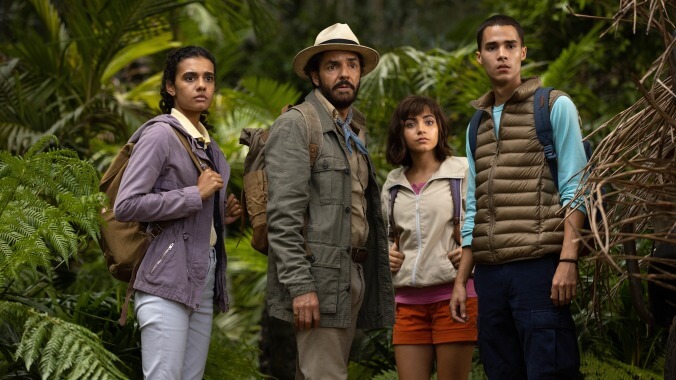Diego, having moved to Cali earlier, is more acclimated to this culture, and warns his tirelessly friendly cousin to stay away from the likes of Sammy (Madeleine Madden), an imposing and high-achieving valedictorian-in-waiting, and Randy (Nicholas Coombe), a garden-variety dork. The movie’s sociological observations about the terrors and pitfalls of high school aren’t exactly up to the standards of Mean Girls. Though Moner’s incongruous good cheer and (inconsistent) naiveté is often funny, it’s not as clever or specific as the similarly positioned 2007 re-do of Nancy Drew.
Of course, Dora And The Lost City Of Gold, like that Nancy Drew movie, isn’t really for teenagers, any more than High School Musical is; it’s for tweenage-and-younger kids who look toward the high-school horizon with a combination of aspirational awe and chilling fear. It also doesn’t spend much time in high school. Before long, Dora, Diego, Sammy, and Randy are snatched by mercenaries in pursuit of Dora’s parents and the hidden golden city. Before the bad guys have a chance to interrogate them, the kids are freed by Alejandro (Eugenio Derbez), another academic, who provides nominal adult supervision as the group sets off into the jungle to find Dora’s parents. After dabbling in Disney Channel coming-of-age, Dora becomes more like Tomb Raider, if Lara Croft was befriended by a cartoony monkey and bedeviled by a bipedal masked fox.
Yes, the reality of Dora And The Lost City Of Gold is elastic enough to accommodate Swiper, recurring villain of the preschool cartoon show, here voiced by Benicio Del Toro (ideally mumbly, given that the extent to which others can understand the character is never made clear). Boots the monkey also appears, fresh from the uncanny valley (and, as Dora’s mom notes, “not meant to wear human clothes”). Though the aesthetic of the original Dora is variously depicted by the movie as a child’s fantasy or a trippy hallucination, the monkey and the fox both bounce through the narrative freely, inspiring only mild amazement. (Sammy, amusingly, fails to see the function of an anonymity-preserving mask on a fox.)
These inconsistencies may cement Dora as a future subject of loud what-were-they-thinking podcasts. But director James Bobin and co-writer Nicholas Stoller previously worked together on the most recent Muppet movies, which is to say they know when it’s more expedient to hand-wave plot points in favor of silly gags. Their update of Dora is nowhere near as funny as their revitalized Muppets—the dialogue often feels like it’s been fed through a Nickelodeonization machine, adding kiddie-level sarcasm and joke-underlining—while still landing enough laughs to qualify as clever. The project also has pervading sense of sincere but knowing dorkiness, from Dora’s parents earnestly warning her about the dangers of raves to a peril sequence that demonstrates actual techniques for escaping quicksand.
Even if Dora takes a little too much time to reach the climactic adventure-movie “jungle puzzles,” as Randy excitedly refers to them, Bobin keeps the adventure brisk and surprisingly credible-looking, with bright but not overlit cinematography from Javier Aguirresarobe. The target audience for Dora And The Lost City Of Gold is, granted, somewhat narrow; by the time kids outgrow the cartoon version, it may only be a few years before they’re old enough to consider the spate of Amblin-imitating kid-adventure throwbacks, or even proper Indiana Jones movies. But it’s encouraging to see a sweet-natured, entertaining alternative to the cartoons and superheroes that are expected to occupy most 7-to-12-year olds—especially when that alternative features a nearly all-Latinx cast. Moner has the trickiest part, requiring her to embody the spirit of a child but the pluck of a more capable teenager. She makes Dora so endearing that even viewers who have little experience with the show may somehow feel a twinge of nostalgia for it.










































